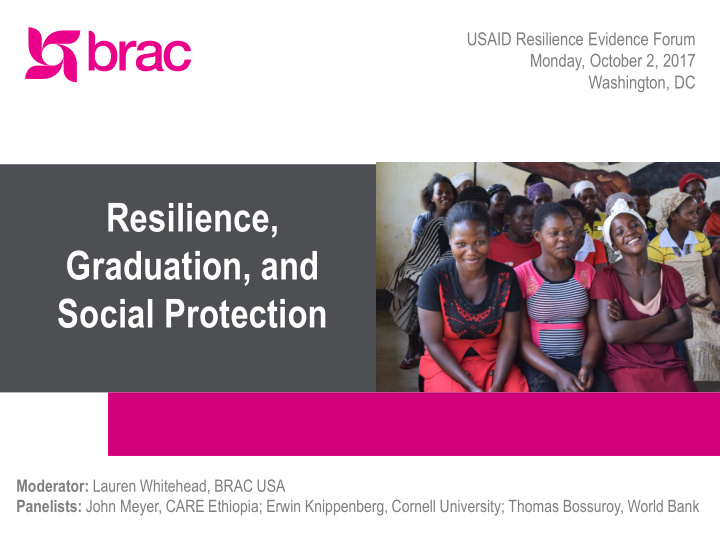



USAID Resilience Evidence Forum Monday, October 2, 2017 Washington, DC Resilience, Graduation, and Social Protection Moderator: Lauren Whitehead, BRAC USA Panelists: John Meyer, CARE Ethiopia; Erwin Knippenberg, Cornell University; Thomas Bossuroy, World Bank
BRAC ULTRA-POOR GRADUATION SESSION PANEL John Meyer, Thomas Bossuroy, Lauren Whitehead, Erwin Knippenberg, CARE Ethiopia World Bank BRAC USA Cornell University
BRAC ULTRA-POOR GRADUATION REDUCING CHRONIC VULNERABILITY Graduation is predicated upon providing a set of time-bound, tailored, and sequenced interventions that offer essential support along four foundational pillars of the approach. Transformative Capacity Adaptive Capacity Absorptive Capacity
BRAC ULTRA-POOR GRADUATION CASE STUDY: SOUTH SUDAN Graduation participants outperformed peers in spite of outbreak of renewed conflict and violence. Challenges Impacts Critical Inputs Renewed conflict and violence More productive and secure Savings & asset accumulation Displacement and migration sustainable livelihoods Health and nutrition education Disrupted access to markets Increased knowledge, skills Community integration Rising healthcare needs and confidence Communal agriculture inputs Hyperinflation (90%) Strengthened community Peer training facilitation systems Joint decision-making training Key Results 97% experienced increase in consumption 71% accessing 2+ income sources 61% trained community peer trainers 53% less likely to have underweight children CU5 compared to control 90% engaged in community committees, links to government/private sector Increased sustainable agriculture Free access to rotating health fund
BRAC ULTRA-POOR GRADUATION GLOBAL GRADUATION With 60+ programs in 40 countries, Graduation is being integrated into development programs around the world. BRAC Bangladesh – Since 2002 CGAP-Ford Foundation Pilots – 2006-2014 NGO-implemented – Since 2010 Donor-implemented – Since 2013 Government-implemented – Since 2013
BRAC ULTRA-POOR GRADUATION ENABLING ENVIRONMENT While Graduation can be implemented in diverse contexts, certain enabling factors contribute to greater propensity for success, particularly key considerations in designing for resilience. Design Considerations (Lesotho): National CCTs and unemployment services • • Asset packages and training adapted to climate change-affected ecological zones • Inability to access local and regional markets Atypical demography affecting labor pool • caused by “missing middle” due to HIV/AIDS • Social capital rebuilt through collectives and support groups in response to epidemic Features of An Enabling Environment Design Considerations (Kenya): Existing social protection programs Existing national cash transfer (HSNP) • Local implementation partners Recurrent climate-induced shocks • Ability to conduct market assessment Climate agriculture-affected agriculture for • Government extension workers semi-pastoralist and pastoralist communities Inter-ministerial coordination • Remote and hard-to-reach communities Case management (frontline staff) Gendered labor practices and care burden • Budget allocation Insufficient availability of basic services •
BRAC ULTRA-POOR GRADUATION Join us in the movement to end ultra-poverty. Contact us to learn more. BRAC Centre BRAC USA 110 William Street, 18 th Floor 75 Mohakhali Dhaka 1212 New York, NY 10038 Bangladesh USA
Recommend
More recommend